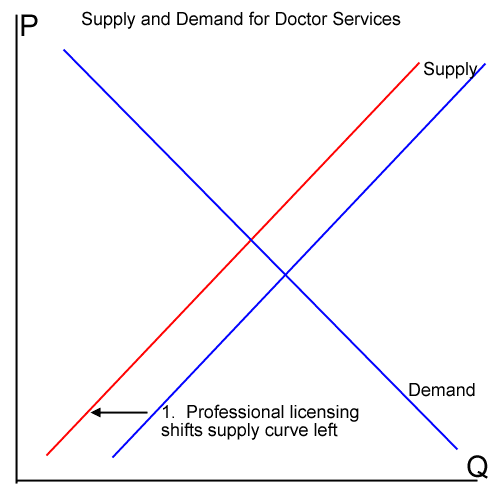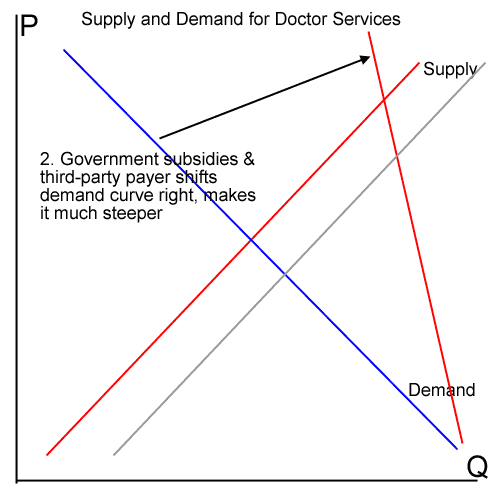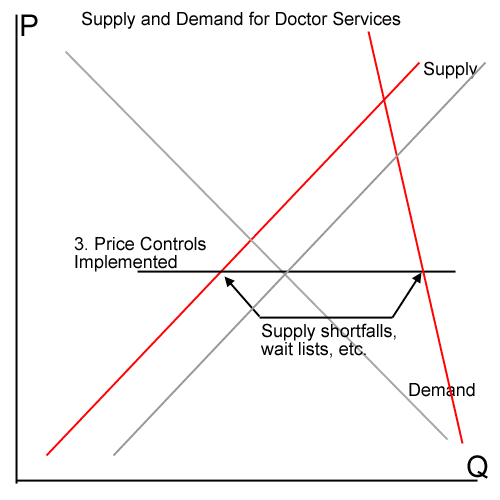How Government Interventions Affect Health Care Supply and Demand
My son is in Freshman econ 101, and so I have been posting him some supply and demand curve examples. Here is one for health care. The question at hand: Does government regulation including Obamacare increase access to health care? Certainly it increases access to health care insurance, but does it increase access to actual doctors? We will look at three major interventions.
The first and oldest is the imposition of strong, time-consuming, and costly professional licensing requirements for doctors. At this point we are not arguing whether this is a good or bad thing, just portraying its inevitable effects on the supply and demand for doctors.
I don't think this requires much discussion. For any given price for doctor services, the quantity of doctor hours available is certainly going to increase as the barriers to entry to the profession are raised.
The second intervention is actually a set of interventions, the range of interventions that have encouraged single-payer low-deductible health insurance and have provided subsidies for this insurance. These interventions include historic tax preferences for employer-paid employee health insurance, Medicare, Medicaid, the subsidies in Obamacare as well as the rules in Obamacare that discourage high-deductible policies and require that everyone buy insurance rather than pay as they go. The result is a shift in the demand curve to the right, along with a shift to a more vertical demand curve (meaning people are more price-insensitive, since a third-party is paying).
The result is a substantial rise in prices, as we have seen over the last 30 years as health care prices have risen far faster than inflation
As the government pays more and more of the health care bills, this price rise leads to unsustainably high spending levels, so the government institutes price controls. Medicare has price controls (the famous "doc fix" is related to these) and Obamacare promises many more. This leads to huge doctor shortages, queues, waiting lists, etc. Exactly what we see in other state-run health care systems, The graph below posits a price cap that forces prices back to the free market rate.
So, is this better access to health care?
I know that Obamacare proponents claim that top-down government operation is going to reap all kinds of savings, thus shifting the supply curve to the right. Since this has pretty much never happened in the whole history of government operations, I discount the claim. When pressed for specifics, the ideas typically boil down to price or demand controls. Price controls we discussed. Demand controls are of the sort like "you can't get a transplant if you are over 70" or "we won't approve cancer treatments that only promise a year more life."
Most of these do not affect the chart above, since it is for doctor services and most of these cost control ideas are usually doctor intensive - more doctor time to have fewer tests, operations, drugs. But even if we expanded the viewpoint to be for all health care, it is yet to be demonstrated that the American public will even accept these restrictions. The very first one out of the box, a proposal to have fewer mamographies for women under a certain age, was abandoned in a firestorm of opposition from women's groups. In all likelihood, there will be some mish-mash of demand restrictions, determined less by science and by who (users and providers) have the best lobbying organizations.
My longer series of three Forbes articles on this and other economic issues with Obamacare begin here: Part 1 Information, Part 2 Incentives, Part 3 Rent-Seeking
Update: Pondering on this, it may be that professional licensing also makes the supply curve steeper. It depends on how doctors think about sunk cost.




Question why would it change the slope of the demand curve rather than shift the whole Demand curve to the right?
I have a female employee, age 33, found with 4 small extremely earlier stages of a fast growing cancer.
Under Hillarycare, the proposed statute made it a criminal violation to have a mammogram under age 50 (except in limited situations - possible brack test, family history, etc). We then morph into Obamacare with the panel with the regulatory authority to limit health care purchases/services. With the current literature proscribing fewer mammograms, it would be unlikely that a few years into obamacare that this employee would be able to get a mammogram.
In other words under both Hillarycare and Obamacare, this employee would be dead in less than 5 years.
Because the as the portion of health care service costs paid by the ultimate consumer of those services, the consumer becomes less sensitive to price making the demand curve less price elastic. Though the starting curve itself should be steeper, because even with the consumer paying full costs, it is likely that health care spending would be less price elastic than many other goods & services.
Here's something else to ponder. State-mandated licensing is NOT the cause of the physician shortage in the USA. The cause is the federal government. The USA population increased from 227 million in 1980 to 309 million in 2010. The over-65 population increased from 25 million to 40 million. With a 36% increase in total population, a 56% increase in the elderly population, and the ability to treat more diseases than ever before, the need for physicians increased by at least 70% since 1980. But, the number of medical schools did not change, and medical school enrollment increased by less than 10% (~16,000 in 2010).
Two factors caused this illogical situation: 1. The federal government decided in the 1970s that there were too many physicians. 2. The federal government has been funding medical school education for decades, the schools became addicted to the money, and a medical school that accepts too many students (as defined by the federal government) loses funding.
The insufficient numbers of USA medical school graduates resulted in a massive increase in the numbers of foreign physicians practicing in the USA. However, that influx was insufficient to meet demand. The physician shortage combined with increased third party payments for routine medical care resulted in medical care costs rising at twice the rate of inflation.
It is noteworthy that the Obama administration encouraged medical schools to add more students: last year's enrollment was 18,000. Why the change of policy? Because Obama knows that many physicians will despise ObamaCare, and that tens of thousands of physicians will retire or leave the USA. Unfortunately, the increase in medical students today will not help until the students have completed four years of medical school and at least three years of residency training. If ObamaCare is not repealed, patients can expect longer and longer waits for medical care.
I am not sure if I am agreeing or disagreeing with Warren on this. I agree that over time this will be the result. But, what I think the main problem with these types of programs is that they are foolers in that at first the socialization of medicine will "work". The reason for this is that most of the cost of medicine are fixed costs with high capital investments, and that most of the charges that relate to care are an allocation of these fixed costs. The variable costs are almost neglgible compared to these fixed cost. SO over the near term everything works like normal.
Consider a hospital. If they have 100 rooms and 80 patients, the marginal variable cost of the 81st room for the night is almost zero. Consider an MRI, the variable cost for the MRI procedure is very low compared to what they charge you. Consider a pharmacuetical, the actual cost to manufacture the drug is limited compared to the huge amounts of R&D investment it took to develop it.
So, in this fixed world, if there are price controls nothing much really happens at first. If you have a hospital, MRI machine, or new drug you will simply be forced to accept a lower return on your capital and longer periods to recover your investment. Even doctors who have a large sunk cost in their education and experience will almost all still maintain their practice because what other options do they have?
But, what happens to socialized medicine industries is that over time it is impossible to make a return in new capital investments. No other investors want to invest in another MRI machine, hospitals will not be able to afford to expand the number of beds, and drug companies will not ahve incentives to create new cures. Eventually, you get the drift into the lower levels of care that the Europeans and Canadiens have.
You often here the "universal health care" proponents talk about how an MRI in Canada is "only" $300, or some such number compared to the much higher price in the US. They believe that this PROVES the socialized medicine advantage. The problem with this claim, though, is that the two commodities are not the same. No one remarks how it cost $1.79 for a soda at the gas station conveneince store versus $0.40 for the same soda at Wal-Mart. The reason for the difference is that htey are not the same commodity. Time and place are also distinguishing characteristics of a commodity. Getting an MRI within a week is a much different commodity than getting an MRI 6 to 12 months from now.
The price you pay for the wait is also an unseen cost. If you have to wait for a needed medical procedure the price you pay is the everyday pain and suffering that you bear from your illness or injury. In some cases, this price is the ultimate price of death as the "inexpensive" health care system does not have the early diagnostics or the newest technologies for combating your disease or injury. This is born out in medical results. For example, the five year live expectency of a breast or prostate cancer patient in the US is over 95%, while in Europe it is about 75%. The broken window effect of pain, misery, and death are simply not measured.
And, to use the slogans of the Left on this issue, what they believe is that we can have "Medicare For All", but the base reality is that you cannot have that. Instead, what will happen is "Medicaid For All", and that is a much harsher proposition.
"For any given price for doctor services, the quantity of doctor hours available is certainly going to increase as the barriers to entry to the profession are raised." Seems like it would be the other way around. As the entry barrier to the profession is lowered, the quantity of hours available will increase.
Play it again, Sam.
I'm Canadian, you are 100% correct, and I remain shocked at the stupidity of the USA in adopting socialized health care after we and the Brits with their NHS have proven that it sucks.
And who will be in charge of "Demand Control"? Why, I do believe it will be a Death Panel, even though called a "Demand Analysis Authority". Orwell would be so proud.
Thanks for the answer, but lets assume for a minute the point at which 0 people will ask for healthcare is with a cost of $3million. Now the governement steps in,and insurance steps in, you don't think some folks will now demand a $5 million operation because the insurance now covers it - and lobby legislators to get this operation manditorially included, etc? I still think that subsidizing health care moves the whole curve to the right. Changing the slope implies that only lower cost services/plans are in greater demand,(eg Free birth control) I would say all services are in greater demand.
It has been 30 years since I took an economics class - maybe I have jsut forgotten how this all works. Somehow though, I think I am on to something.
"I don't think this requires much discussion. For any given price for
doctor services, the quantity of doctor hours available is certainly
going to increase as the barriers to entry to the profession are raised."
i think this is a typo. hours decrease with barriers to entry (as shown in the graph), not increase. q drops in that graph and would drop even more if p was constant.
Never mind, I figured it out. I was hopelessly confused. Thanks for your help Matt.
decrease.
Signed,
Warren's pro bono proofreader/guy who needs his own blog.
Just what i was looking for. I would like to see a graph that isolates the demand of the rich vs the poor. i realized that on the way home today that demand will sky rocket for the poor while the cost of insuring the poor is shifted to those who can afford more expensive plans. as this cost is shifted these people will undoubtedly choose cheaper plans which do not offer as good of coverage, decreasing demand for high quality healthcare. diminishing the overall quality of top healthcare. while everyone is covered so to speak, the consequence is clearly lower quality healthcare. it makes sense that they would force people to buy insurance because without that bottom end there is no way insurance companies would be able to compensate or there loses from the top end consumers.
question here: when barriers are raised in time of physician deficit less physicians enter and supply decreases, right? so in times of physician deficit you need to to lower barriers in order to increase supply?
thanks